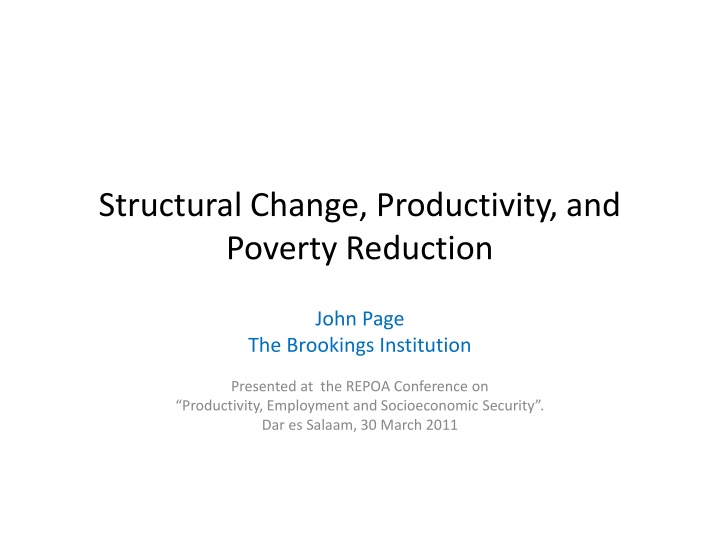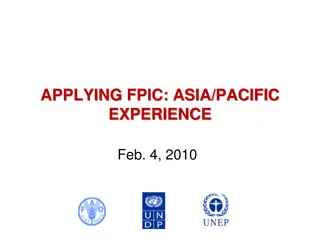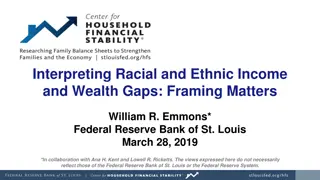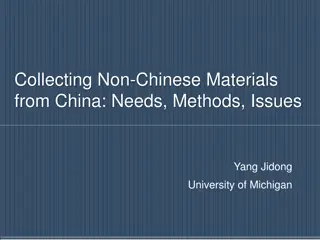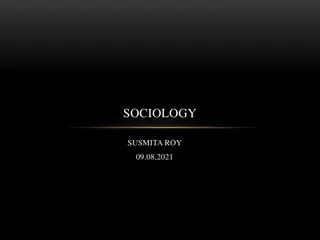Ethnic Minorities and Sustainable Development Challenges
Ethnic minorities often face social and economic exclusion, impacting their labor market outcomes. Definitions and recognition of ethnic minorities vary globally, leading to discrepancies in addressing their needs. The UN Special Rapporteur on Minority Issues emphasizes the importance of specific goals in the global development agenda to promote social inclusion and reduce inequality for disadvantaged minority groups.
Download Presentation

Please find below an Image/Link to download the presentation.
The content on the website is provided AS IS for your information and personal use only. It may not be sold, licensed, or shared on other websites without obtaining consent from the author.If you encounter any issues during the download, it is possible that the publisher has removed the file from their server.
You are allowed to download the files provided on this website for personal or commercial use, subject to the condition that they are used lawfully. All files are the property of their respective owners.
The content on the website is provided AS IS for your information and personal use only. It may not be sold, licensed, or shared on other websites without obtaining consent from the author.
E N D
Presentation Transcript
Structural Change, Productivity, and Poverty Reduction John Page The Brookings Institution Presented at the REPOA Conference on Productivity, Employment and Socioeconomic Security . Dar es Salaam, 30 March 2011
Rediscovering Structural Change Structural change the movement of resources from low productivity to high productivity employment - is a foundational idea of development economics (Kuznets, Lewis, Chenery) Historical and cross country evidence suggests that it should be most relevant for countries at low levels of income As incomes rise, productivity differences among sectors (and enterprises) tend to converge
Rediscovering Structural Change Academic interest in structural change waned in the 1980s Cross country regressions consigned it to the residual The result for public policy was a focus on whole economy drivers of growth such as openness, institutions, governance, etc. These prescriptions proved to be of little practical relevance to public policy
Rediscovering Structural Change Recent academic research has rediscovered the importance of differences in productivity levels among firms (Hsieh and Klenow) Very recently, some academic attention has returned to the implications of productivity differences between sectors (McMillan and Rodrik).
Africa has the most to gain from structural change Productivity differences among sectors are greatest
A simple decomposition Y = i ,t-k y i, t+ y i, t i, t Overall = Within Sector + Structural Productivity Productivity Change Change Change Yields a worrisome result
Decomposition of productivity growth, unweighted averages, 19902005 Labor productivity growth Due to within sector productivity growth Due to structural change ASIA HIGH INCOME LAC AFRICA 3.87% 1.46% 3.31% 1.54% 0.57% 0.09% 1.35% 0.86% 2.24% 2.13% 0.88% 1.27% Source: McMillan and Rodrik (2011)
Perverse structural change slows productivity growth Source: McMillan and Rodrik (2011)
Structural Change and Poverty Reduction Higher productivity creates scope for poverty reduction through rising real wages But productivity increases within sectors or firms may result in a net reduction in employment Where the workers displaced go can have an important impact on poverty outcomes the extreme case is unemployment The recent experience of Latin America and Africa suggests that workers are moving to lower productivity jobs
Labor productivity and poverty reduction 20 10 0 -10 -20 -2 0 2 4 6 8 Rate of Labor Productivity Growth Fitted values Rate of Poverty Reduction Rate of Poverty Reduction = 0.77 0.83*Growth of Labor Productivity: t= -1.28 r2 = 0.0615
Structural change and poverty reduction 20 10 0 -10 -20 -4 -2 0 2 Structural Change Fitted values Rate of Poverty Reduction Rate of Poverty Reduction = -2.17 2.68*Structural Change: t = -4.06 , r2 = 0.3979
Policy, strategy and structural change The focus on whole economy reforms and on within sector (or firm) productivity has led to an extreme focus on the investment climate Investment climate reforms focus on Institutional and policy reforms doing business Infrastructure and education Beyond the investment climate Many of the economic activities needed for structural change are lumpy in size, space and time. Once a minimum threshold of activity is reached growth can be sustained, but below that threshold marginal improvements may not yield the intended results. Lumpiness implies the need for a coherent strategy
Policy, strategy and structural change The Role of the State Externalities and coordination failures are at the center of lumpiness and call for public action The debate about picking winners misses the point: governments make industrial policy on a daily basis via the budget, regulations and trade policy. The issue is whether these decisions have a strategic focus. In Africa they frequently do not.
Policy, strategy and structural change Some strategic options Transforming agriculture Breaking in Managing natural resource wealth
Transforming agriculture Agricultural yields have stagnated or declined in Africa for 40 years. Crop yield losses range from modest to significant, depending on crop, soil type, climate and production systems. Asia's productivity has increased threefold during the same time period If current productivity levels are maintained, Africa will probably have lost global competitiveness in all of its main agricultural products by 2050
Transforming agriculture: Some elements of a strategy Funding and certifying the use of new GM technologies appropriate to their agro climatic conditions Introducing intensive agriculture through consolidation of holdings and commercialization Clarifying the nature and duration of land rights claims; formalizing the terms of deeds, contracts and registration; and improving ways to document and uphold claims Developing national programs for soil management Rehabilitating agricultural innovation systems Entering global value chains for processed agricultural and agro-industrial products.
Breaking in: What you make matters Economies with more sophisticated manufacturing sectors grow faster Sophisticated products embody advanced country knowledge and productivity As the manufacturing base moves from low sophistication to higher sophistication activities, new export opportunities arise Knowledge becomes more generalized and productivity rises More diverse economies have higher incomes. More diverse economies are better able to take advantage of opportunities in global markets A wide range of industrial activities provides a broad basis for the entry and exit of firms Increasing diversity and sophistication require breaking into the global economy
What you make matters: Fast growing countries were all increasing the intensity of high sophistication manufacturing. Slow growing countries were not Evolution of production intensity 1975-2005 Relatively sophisticated industries - 1 .5 OECD HIGH INTENSITY 0 LOW INTENSITY Fast Growing -income mid -.5 stagnant low - income stagnant -1 mid -income -income Fast Growing low -1.5 6000 8000 10000 12000 14000 16000 18000 Income per capita associated with sector of production
Out of Africa: Deindustrialization 1975-2005 Mfg Exports PC 2005 (US$) Growth PC Exports 00-05 (%) Share Mfg Export s in Total (%) Share Medium/ High Tech in Total Mfg Exports (%) Mfg. Value Added PC 2005 (US$) Share of Mfg in GDP 2005 (%) Change in Mfg Share of GDP 00-05 Africa Average 39.0 1.65 54.9 13.3 63.6 07.6 _ All Devel- ping Countries 487.2 10.05 75.8 57.3 372.9 21.7 +
Out of Africa: Manufacturing Sectors Have Become Less Sophisticated - 1 High Sophistication Sectors .5 OECD HIGH INTENSITY 0 LOW INTENSITY Fast growing -.5 mid -income -1 AFRICA stagnant mid -income -1.5 low -income Fast growing 1975-1981 1995-2003
A strategy for breaking in: Creating an export push Make existing incentives work at the border and beyond. Focus infrastructure on exports Get serious about trade logistics Find and fix the key bottlenecks in the value chain (ports, transport, data) Exchange rate protection ?
A Strategy for breaking in: Spatial industrial policy Manufacturing and service industries tend to concentrate in geographical areas usually cities. Africa s economies have few modern industrial clusters, making it both more difficult for existing firms to compete and more difficult to attract new industry. Governments can foster agglomerations by concentrating investment on high quality institutions and infrastructure in a limited physical area such as a special economic zone (SEZ).
A Strategy for breaking in: Special Economic Zones The first order of business is to upgrade the performance of SEZs to international standards. Connect SEZs to the national development strategy Establish the conditions for ongoing exchange between the domestic economy and activities based in the zone. Regional SEZs often called growth corridors - can be developed around key trade infrastructure (ports, roads, power projects), with domestic industry clusters and local labor markets.
Managing resource wealth New discoveries and rising demand will increase the importance of natural resources Resource rich economies have economic structures that impede long run growth Concentration of production in services and resource sector Agriculture and Industry small and declining Lack of product and export sophistication
Natural resources and Economic Structure in Africa Country Type Share of Agriculture in GDP Share of Manufac- turing in GDP Manufac- turing Value Added (MVA) Per capita Share of Medium and High Technology in Total MVA Share of Manufac-turing in Total Exports Share of Medium and High Technology in Manufactured Exports Number of Exports Accounting for 75%of Total Exports Resource- rich Economies 9.8 7.9 91.1 15.6 50.2 10.3 2.9 Non Resource- rich Economies 18.1 12.1 121.8 15.1 59.1 16.8 24.0 20.3 11.9 96.5 14.6 58.5 15.2 24.0 Excluding South Africa East Asia 29.5 582.3 97.5 91.9 64.1 Least Developed Countries 10.0 31.4 2.6 43.1 6.6
Managing resource wealth: Geology is not destiny Three resource-rich industrializers from outside Africa Chile, Indonesia, and Malaysia show quite different but successful patterns of structural change and growth Indonesia and Malaysia used natural resource revenues to industrialize Chile invested in knowledge based agro-industry (salmon; wine).
Geology is not destiny: Structural change in production
A strategy for managing resource wealth: Public investment choices Savings can be invested in foreign or domestic assets Rates of return should determine the choice But it is often hard to determine the benefits of investments in institutional, physical or human capital Need for a prioritized list of investments Investing to invest Investing in knowledge
Conclusions It s time to take structural change seriously, again It s good for growth It s good for poverty reduction Africa has the greatest structural change potential But, since at least 1990 perverse structural change has reduced productivity and increased poverty
Conclusions Marginal reforms may not be sufficient to reverse the trend Three strategic options appear to hold promise Transforming agriculture Breaking in Managing natural resource wealth These strategic options are not mutually exclusive All require careful evaluation
